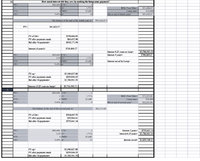Hello, I am currently taking a course in creating and solving problems for financial situations and I'm currently stuck on K and L of the following question.
The Mackenzie’s also bought a business for $90,000. They borrowed the money to buy the business at 6.9% compounded semi-annually and are to repay the debt by making quarterly payments of $3645.
k. How much interest do they save by making the lump sum payment?
l. If Bob and Angelique had made the lump sum payment at the end of the second year instead of the end of the fourth year, how much more money could they save?
If anyone could help solve them I'd greatly appreciate it!!
The Mackenzie’s also bought a business for $90,000. They borrowed the money to buy the business at 6.9% compounded semi-annually and are to repay the debt by making quarterly payments of $3645.
k. How much interest do they save by making the lump sum payment?
l. If Bob and Angelique had made the lump sum payment at the end of the second year instead of the end of the fourth year, how much more money could they save?
If anyone could help solve them I'd greatly appreciate it!!

